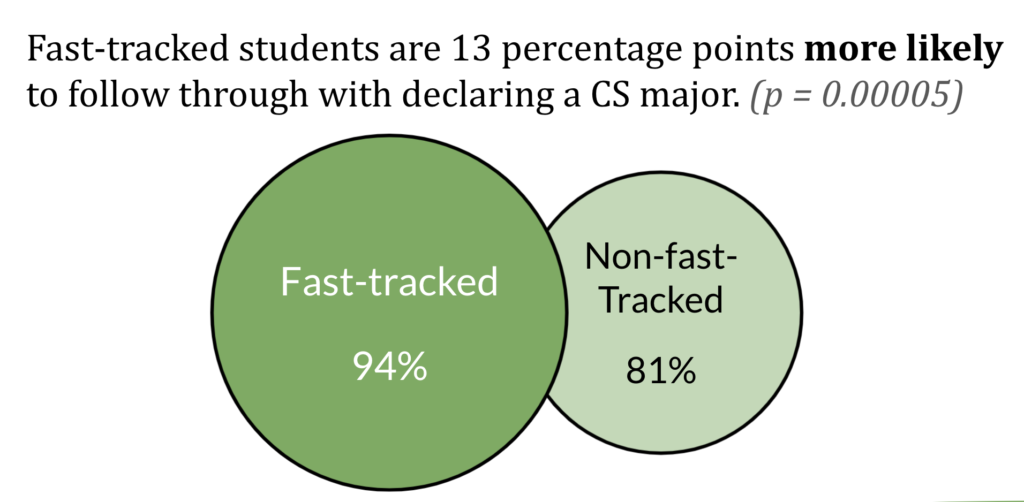Study finds new opportunities, challenges to broadening CS education
There are many avenues for a student to develop an interest in a computer science major – unique among many other fields, its cross-disciplinary relevance draws students from all across campus. But a study on CS retention rates reveals that success is biased toward those who set out on the most traditional route and tackle the major as early as possible.
“Enrollments continue to rise in Computer Science courses, yet fostering inclusive climates and retaining diverse student bodies remain key challenges,” writes CS undergraduate researcher Fee Christoph. A study she conducted with co-authors Prof. Westley Weimer and alum Dr. Kevin Angstadt (PhD CSE 2020) set out to find under-studied points in the CS pipeline where students may have a higher chance of being discouraged and changing majors.
A number of studies have focused their attention on the earliest points of this pipeline, the introductory courses, in attempts to answer how best to introduce more people to the discipline early. But less work has been done to determine what may lead students to leave the major when they’re further along.
Christoph’s study set out to explore this point further along the pipeline, with a focus on the third class in the sequence (“CS3”) filled by EECS 281: Data Structures and Algorithms. This is the point in the program where students can go on to declare the major and finish out with upper level courses. In her study, she conducted an analysis of archival data for EECS 281, analyzing anonymized student assignments and university student records to identify factors that result in students choosing not to declare the major.
In particular, they compared student outcomes (grades and whether they later declared a major in CS or a related field) with their survey input indicating whether they intended to continue the major.
“What starts to impact students at that specific level?” Christoph asked. “We wanted to find out what problems were unique there so that we can better support those students in the future.”
The problem with losing track of this group of students, the researchers say, is that they’re a group who have already sunk significant time and effort into the major by the time they depart. Finding a way to ensure fewer students feel they need to cut their losses that far into the major can help reduce stress in the program.
Earlier in the pipeline, a number of expected factors can lead to students not staying in CS – things like gender, prior exposure to the material, and socioeconomic status. But according to Christoph, these factors aren’t as relevant by the time students make it to CS3.
“We found consistently cropping up in our data that there’s another group of students who did end up declaring at lower rates than they intended to,” says Christoph. “This demographic is made up of students who either got to EECS 281 late in their college career, or had a larger gap between EECS 280 and 281.” EECS 280: Programming and Introduction to Data Structures is the CS2 course offered by U-M.
The researchers classify students who took the entry classes to CS early and in a shorter timeframe as “fast-tracked” students. Fast-tracked students usually take EECS 280 and 281 with at most a one semester gap. Non-fast-tracked students are often associated with non-traditional students, including returning adult students and students who change their major.

“That was interesting for us because it’s an under-studied group,” Christoph says.
It turns out the distinction has a noticeable effect on student experience. Students who aren’t fast-tracked are 13% less likely to actually declare a CS major, and their performance in class projects tends to suffer as well. In fact, the longer the semester gap between a student taking CS2 and CS3, the less likely they are to continue with the CS major.
“Critically,” the authors write, “students who intend to declare a major but ultimately leave perform a letter grade lower (on average) than students who declare.”
The finding reveals a difficult problem – the model of quickly advancing students through introductory courses early in their college career does indeed seem to help with retention in the major, the authors write, but it simultaneously leaves behind those who arrive at CS in a more roundabout way.
“Higher grades are associated with higher retention rates of CS majors, and the current curriculum significantly favors fast-tracked students,” writes Christoph.
While the problem still merits closer observation, among the authors’ preliminary recommendations is more direct encouragement of taking CS2 and CS3 back to back, with additional support mechanisms for students who arrive at the field later.
“Our results suggest that identifying non-fast-tracked students may be a more fruitful approach for intervention efforts seeking to increase major retention,” the authors suggest. This method would be more useful than identifying struggling students by grades alone, they add, as grades actually vary widely among students who do declare the major.
The authors hope to see continued efforts to explore this critical juncture as an opportunity to create a more equitable computer science curriculum.
 MENU
MENU 
